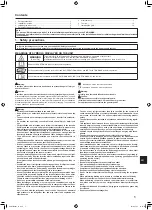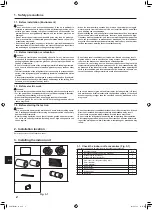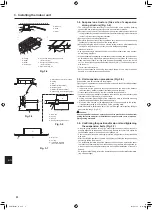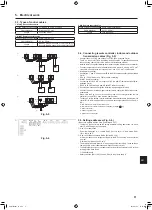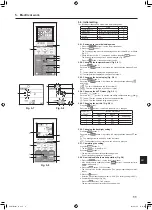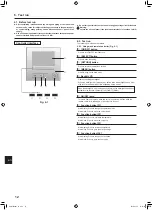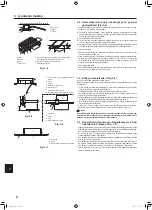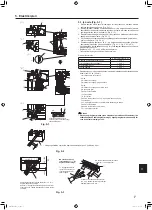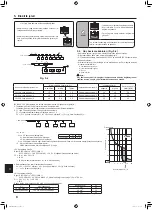
12
en
6.2. Test run
The following 3 methods are available.
6.2.1. Using wired remote controller (Fig. 6-1)
▌
1
[ON/OFF] button
Press to turn ON/OFF the indoor unit.
▌
2
[SELECT] button
Press to save the setting.
▌
3
[RETURN] button
Press to return to the previous screen.
▌
4
[MENU] button
Press to bring up the Main menu.
▌
5
Backlit LCD
Operation settings will appear.
When the backlight is off, pressing any button turns the backlight on and it will
stay lit for a certain period of time depending on the screen.
When the backlight is off, pressing any button turns the backlight on and does
not perform its function. (except for the [ON/OFF] button)
▌
6
ON/OFF lamp
This lamp lights up in green while the unit is in operation. It blinks while the
remote controller is starting up or when there is an error.
▌
7
Function button [F1]
Main display: Press to change the operation mode.
Main menu: Press to move the cursor down.
▌
8
Function button [F2]
Main display: Press to decrease temperature.
Main menu: Press to move the cursor up.
▌
9
Function button [F3]
Main display: Press to increase temperature.
Main menu: Press to go to the previous page.
▌
0
Function button [F4]
Main display: Press to change the fan speed.
Main menu: Press to go to the next page.
Controller interface
Fig. 6-1
► Do not carry out this test on the control wiring (low voltage circuit) terminals.
Warning:
Do not use the air conditioner if the insulation resistance is less than 1.0 MΩ.
6.1. Before test run
► After completing installation and the wiring and piping of the indoor and
outdoor units, check for refrigerant leakage, looseness in the power supply
or control wiring, wrong polarity, and no disconnection of 1 phase in the
supply.
► Use a 500-volt megohmmeter to check that the resistance between the power
supply terminals and ground is at least 1.0 MΩ.
6. Test run
4
3
2
1
5
6
7
8
9
0
Function buttons
RG79F456H01_en.indd 12
2019/07/03 14:25:32
014
014



